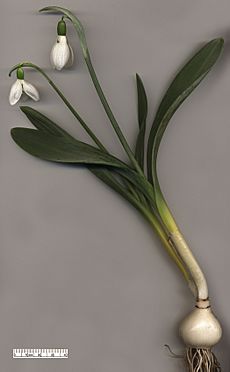Moly (herb) facts for kids
Moly is a special, magical plant that appears in ancient Greek stories. It's famous from Homer's epic poem, the Odyssey. In this story, Moly helps the hero Odysseus stay safe from powerful magic.
Moly in Greek Myths
In the famous story of Homer's Odyssey, the god Hermes gave Moly to Odysseus. This was to protect Odysseus from the magic and poisons of the sorceress Circe. Odysseus needed to rescue his friends, whom Circe had turned into pigs.
Some ancient writers, like Ptolemy Hephaestion and Eustathius of Thessalonica, had a different story about how Moly came to be. They said Moly grew from the blood of a giant named Picolous. This giant tried to attack Circe on her island. Circe's father, the sun god Helios, killed Picolous.
They described Moly as having a black root, like the giant's blood. Its flower was white, perhaps because of the bright sun that killed the giant, or because Circe turned pale with fear. The name "Moly" might even come from a Greek word meaning "hard," referring to the tough fight with the giant.
Homer himself described Moly like this: "The root was black, while the flower was as white as milk." He also said, "The gods call it Moly. It is dangerous for a mortal man to pluck from the soil, but not for the deathless gods. All lies within their power." The Roman poet Ovid also mentioned it in his Metamorphoses as "A white bloom with a root of black."
What Real Plant is Moly?

People have wondered for a long time if Moly is a real plant. Some think it's just a magical plant from a story and doesn't exist in the real world.
However, many scientists and historians have tried to guess which real plant could be Moly.
- Kurt Sprengel thought it was Allium nigrum, a type of onion.
- Others suggested Allium moly, which is actually named after the mythical herb. But this plant has yellow flowers, not white.
- Philippe Champault believed it was Peganum harmala, also known as Syrian or African rue. This plant has white flowers with green stripes.
- Victor Bérard thought it might be Atriplex halimus, a common shrub found on Mediterranean coasts.
Some experts, like R. M. Henry, believe "Moly" is just a magical name. It might have come from ancient Egyptian or Phoenician magic. He also thought that the "difficulty of pulling up" the plant wasn't just physical. It was about the special powers that magicians claimed to have.
Some medical historians have a different idea. They think Circe turning men into pigs wasn't meant to be taken literally. Instead, it might describe what happens when someone is poisoned by certain plants. These poisons can cause people to forget things, see things that aren't there, or believe things that aren't true.
If this is true, then Moly could be the snowdrop flower. Snowdrops grow in the same region and contain a substance called galantamine. This substance can help reverse the effects of those kinds of poisons. So, Moly would be a plant that could magically undo bad spells.
Moly in Other Stories and Art
Moly has appeared in many other books, poems, and shows over the years:
- In Tennyson's poem The Lotos-Eaters, Moly is mentioned alongside another plant called amaranth.
- The famous scientist Carl Linnaeus thought the mythical Moly was the golden garlic (Allium moly).
- Thom Gunn named his 1971 poetry collection Moly.
- In the Harry Potter books, Moly is a powerful plant that can be eaten to stop enchantments.
- In John Lyly's play Gallathea, the goddess Diana tells her nymphs to think of love like Moly. She says it has "a white leaf and a black root, a fair show, and a bitter taste."
- John Milton wrote about Moly in his play Comus, saying, "... that Moly / that Hermes once to wise Ulysses gave."
- In Ursula K. Le Guin's book A Wizard of Earthsea, the main character Ged's aunt, a witch, has Moly among her herbs. In The Farthest Shore, students learn the true names of Moly's parts.
- In A.E. Harrow's book The Once and Future Witches, Moly is used in a spell to turn a man into a pig.
- In the Japanese TV show Kyōryū Sentai Zyuranger, the heroes need Moly to defeat a monster called Dora Circe.

